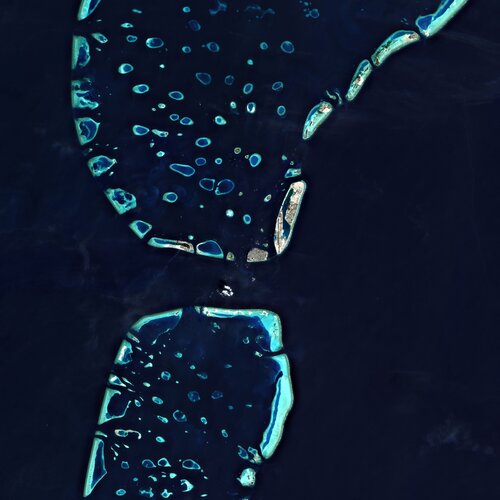
Copernical Team
Lift off for UK spaceflight as regulations passed
 Another step towards space exploration from UK soil has been unlocked, with the passing of the spaceflight regulations, Transport Secretary Grant Shapps announced 29 July 2021.
The legislation provides the framework to regulate the UK space industry and enable launches to take place from British soil for the very first time. It will unlock a potential 4 billion pounds of market opportuniti
Another step towards space exploration from UK soil has been unlocked, with the passing of the spaceflight regulations, Transport Secretary Grant Shapps announced 29 July 2021.
The legislation provides the framework to regulate the UK space industry and enable launches to take place from British soil for the very first time. It will unlock a potential 4 billion pounds of market opportuniti Earth from Space: Malé, the Maldives

The Copernicus Sentinel-2 mission takes us over Malé – the capital and most populous city in the Republic of Maldives.
New Russian lab briefly knocks space station out of position

Russia's Nauka science module docks with ISS

Russia's long-delayed lab module successfully docked with the International Space Station on Thursday, eight days after it was launched from the Russian space launch facility in Baikonur, Kazakhstan.
The 20-metric-ton (22-ton) Nauka module, also called the Multipurpose Laboratory Module, docked with the orbiting outpost after a long journey and a series of maneuvers.
The launch of Nauka, which is intended to provide more room for scientific experiments and space for the crew, had been repeatedly delayed because of technical problems. It was initially scheduled to go up in 2007.
In 2013, experts found contamination in its fuel system, resulting in a long and costly replacement. Other Nauka systems also underwent modernization or repairs.
Explore further
© 2021 The Associated Press. All rights reserved. This material may not be published, broadcast, rewritten or redistributed without permission.
Ground system for NASA's Roman Space Telescope moves into development

When it launches in the mid-2020s, NASA's Nancy Grace Roman Space Telescope will revolutionize astronomy by building on the science discoveries and technological leaps of the Hubble, Spitzer, and Webb space telescopes. The mission's wide field of view and superb resolution will enable scientists to conduct sweeping cosmic surveys, yielding a wealth of information about celestial realms from our solar system to the edge of the observable universe.
On July 23rd, the Roman Space Telescope successfully completed the critical design review of the mission's ground systems, which are spread over multiple institutions including the Space Telescope Science Institute (STScI) in Baltimore, Maryland; NASA's Goddard Space Flight Center in Greenbelt, Maryland; and Caltech/IPAC in Pasadena, California. STScI will host the Science Operations Center (SOC) while Goddard will provide the Mission Operations Center and Caltech/IPAC will house the Science Support Center. The passing of the critical design review means the plan for science operations provides all the necessary data processing and archiving capabilities. The mission will now proceed to the next phase: building and testing the newly designed systems that will enable planning and scheduling of Roman observations and managing the resulting data, anticipated to be over 20 petabytes (20,000,000 GB) within the first five years of operations.
Competing companies developing payload to make air from moondust

ESA is challenging companies in its Member States to design a compact plant to demonstrate the manufacture of oxygen on the Moon. Industrial teams are competing this summer to propose and prove designs through testing, with the winner set to be declared in September. This small piece of technology will evaluate the prospect of building larger plants to produce propellant for spacecraft, air for astronauts and metallic raw materials for equipment.
How the Galileo Project will search the skies for alien technology

Can we find alien technology? That is the ambitious goal of the Galileo Project, launched this week by Harvard astrophysicist Avi Loeb with substantial private financial backing.
The project is far from the first attempt to detect signs of civilisations beyond Earth. Loeb has been criticized in the past for his dismissive approach to previous efforts to find extraterrestrial life and his argument that an alien artifact passed through our solar system in 2017.
So why do Loeb and his collaborators think they have a chance of finding something where others have failed? There are three triggers that suggest they might.
Exoplanets, "Oumuamua, and UFOs
First, years of painstaking observations have shown that many stars host Earth-like planets. There is a real chance these "exoplanets" might be home to alien civilisations.
Second, five years ago, an interstellar visitor, dubbed "Oumuamua, tumbled though our solar system. It was a skinny object about 400 meters long, and we know from its speed and trajectory that it arrived from outside our solar system. It was the first time we had ever seen an interstellar object enter our neighborhood.
Russian lab module docks with space station after 8-day trip

Russia's long-delayed lab module successfully docked with the International Space Station on Thursday, eight days after it was launched from the Russian space launch facility in Baikonur, Kazakhstan.
The 20-metric-ton (22-ton) Nauka module, also called the Multipurpose Laboratory Module, docked with the orbiting outpost after a long journey and a series of maneuvers.
The launch of Nauka, which is intended to provide more room for scientific experiments and space for the crew, had been repeatedly delayed because of technical problems. It was initially scheduled to go up in 2007.
In 2013, experts found contamination in its fuel system, resulting in a long and costly replacement. Other Nauka systems also underwent modernization or repairs.
Explore further
© 2021 The Associated Press. All rights reserved. This material may not be published, broadcast, rewritten or redistributed without permission.
NASA rocket carrying solar X-ray scanner set to launch

The Marshall Grazing Incidence X-ray Spectrometer, or MaGIXS, mission is about to take flight. The launch window opens at the White Sands Missile Range in New Mexico on July 30.
Led by Dr. Amy Winebarger at NASA's Marshall Space Flight Center in Huntsville, Alabama, MaGIXS will fly aboard a sounding rocket, a launch vehicle that lifts scientific instruments above Earth's atmosphere for a few minutes in space before falling back to Earth for recovery.
NASA performs field test of 3D imaging system for descent and landing

Producing rapid and accurate images on missions to the Moon, Mars and other terrestrial destinations is crucial for a safe descent and landing. A NASA project called Safe and Precise Landing—Integrated Capabilities Evolution, or SPLICE, includes a key element that will help ensure a clearer touchdown site.
The SPLICE team recently performed a dynamic test of the hazard detection lidar (HDL) engineering development unit, a prototype specifically built for testing, at NASA's Goddard Space Flight Center in Greenbelt, Maryland. HDL—an element of SPLICE—is a laser-based 3D imaging system that can quickly and accurately scan a planetary surface to create a map of the landing field. It's designed to help a mission avoid hazardous obstacles and land in a safe area.
